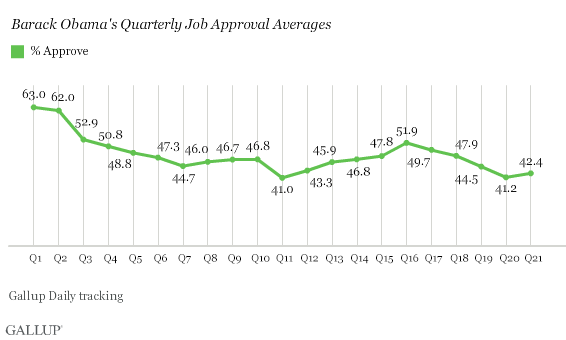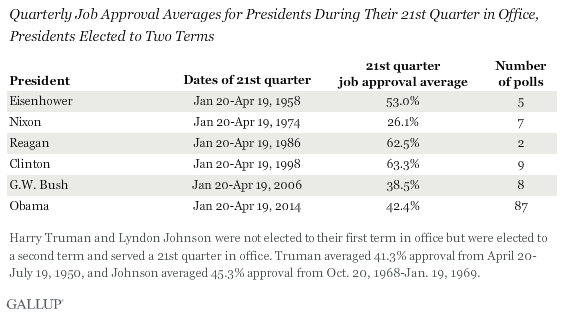PRINCETON, NJ -- President Barack Obama's job approval rating averaged 42.4% during his 21st quarter in office, a slight improvement from 41.2% in the prior quarter, but still one of his lowest quarterly averages as president.

These results are based on Gallup Daily tracking interviews conducted Jan. 20 through April 19. The slight improvement in Obama's average approval rating comes after four consecutive quarters of decline following a 51.9% rating in his 16th quarter, which included his re-election in November 2012.
Even with the improvement, Obama has had only two quarterly averages that were lower than the one just concluded -- 41.0% in his 11th quarter (July 20-Oct. 19, 2011) and 41.2% in the 20th quarter.
Obama's 21st quarter average ranks fourth of the six for the post-World War II presidents elected to two presidential terms. It is significantly lower than those of Bill Clinton, Ronald Reagan, and Dwight Eisenhower, but higher than those of George W. Bush and Richard Nixon. Nixon's 26% average came as he was embroiled in the Watergate scandal, and Bush's as the Iraq war was becoming increasingly unpopular.

Compared with the entire set of 273 presidential quarters for which Gallup has collected data since 1945, Obama's 21st quarter average ranks in the 21st percentile. That is, 20% of all presidential quarterly averages have been lower, and 79% have been higher.
Obama's job approval rating has averaged 48% throughout his presidency to date, which is better than Harry Truman's, Gerald Ford's, and Jimmy Carter's averages during their entire presidencies but lower than the averages for other post-World War II presidents. Obama has 11 quarters remaining in his presidency.
Implications
Despite the uptick in Obama's approval ratings during the last quarter, Obama's average approval rating remains low by historical standards, and could be troublesome for the Democratic Party heading into this fall's midterm elections. While most presidents' parties lose seats in the president's second midterm, the losses have been greater for less popular presidents than more popular presidents. Obama's party may be spared big losses in the House given the large number of seats that flipped from Democratic to Republican during his first midterm election in 2010, but many Senate Democrats remain vulnerable to defeat after having been elected in 2008, a strong Democratic year.
Obama's job approval rating has been higher in the last weeks of the quarter than in the earlier weeks, including his current rating of 44% for the week ending April 20. If Obama's job approval average stays at that slightly higher level during his next quarter, or increases, he would be the only twice-elected president other than Reagan to show even marginal improvement in his 22nd quarter average approval rating from his 21st.
Explore President Obama's approval ratings in depth and compare them with those of past presidents in the Gallup Presidential Job Approval Center.
Survey Methods
Results for this Gallup poll are based on telephone interviews conducted Jan. 20-April 19, 2014, on the Gallup Daily tracking survey, with a random sample of 44,167 adults, aged 18 and older, living in all 50 U.S. states and the District of Columbia.
For results based on the total sample of national adults, the margin of sampling error is ±1 percentage point at the 95% confidence level.
Interviews are conducted with respondents on landline telephones and cellular phones, with interviews conducted in Spanish for respondents who are primarily Spanish-speaking. Each sample of national adults includes a minimum quota of 50% cellphone respondents and 50% landline respondents, with additional minimum quotas by time zone within region. Landline and cellular telephone numbers are selected using random-digit-dial methods. Landline respondents are chosen at random within each household on the basis of which member had the most recent birthday.
Samples are weighted to correct for unequal selection probability, nonresponse, and double coverage of landline and cell users in the two sampling frames. They are also weighted to match the national demographics of gender, age, race, Hispanic ethnicity, education, region, population density, and phone status (cellphone only/landline only/both, and cellphone mostly). Demographic weighting targets are based on the most recent Current Population Survey figures for the aged 18 and older U.S. population. Phone status targets are based on the most recent National Health Interview Survey. Population density targets are based on the most recent U.S. census. All reported margins of sampling error include the computed design effects for weighting.
In addition to sampling error, question wording and practical difficulties in conducting surveys can introduce error or bias into the findings of public opinion polls.
For more details on Gallup's polling methodology, visit www.gallup.com.
